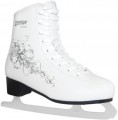Size
The boot sizes of the skates. One skate model can have a full
fixed size grid (
25,
26,
27,
28,
29,
30,
31,
32,
33,
34,
35,
36,
37,
38,
39,
40,
41,
42,
43,
44,
45,
46 size) and include both
kids skates and adults. And for models with
adjustable sizes(see "More features"), size ranges are indicated in this paragraph, while one model can be produced in several range options. For example, the designation "35-38, 39-42" means that the skates are available in two versions: one is adjustable from size 35 to 37, the second is from 39 to 42.
Boot material
The main material used in the outer trim of the boot.
—
Combined synthetics. Combination of different types of synthetic fibers. Specific materials are usually selected with the expectation of resistance to low temperatures and moisture; in general, the combined synthetics are durable, retain heat well, and also do not tend to stretch. At the same time, this material is relatively inexpensive, which makes it very popular, especially in pleasure and hockey skates (see "Skating style").
—
Genuine leather. Quite an expensive and prestigious material: the skin is durable, reliable, impervious to moisture and at the same time allows the foot to “breathe”, and such boots look stylish and solid. In general, this material is considered suitable mainly for figure skating (see "Skating style"), it is practically never found in skates for other purposes. Among the shortcomings of the skin, in addition to the price, one can note the need for special care: shoes must be thoroughly cleaned and treated with special products, otherwise wrinkles and cracks will appear on them.
—
Nylon. Nylon is well suited primarily for recreational and hockey skates: it has good strength and rigidity, combined with low weight. However, such material costs a little more than the same synthetics, and therefore is less common.
—
Artificial leather.... Material that imitates the appearance of genuine leather. Most popular in figure skating models. The quality of leatherette, usually, directly depends on the price category of skates: inexpensive varieties wear out rather quickly, and the most advanced ones are almost indistinguishable from genuine leather. In general, this material is quite soft, but weakly retains heat and does not absorb moisture.
— Plastic. Relatively inexpensive material, which can easily be given almost any colour. At the same time, different types of plastic can be used in modern skates — from inexpensive and relatively fragile to advanced and high-quality ones. So it is best to evaluate the quality of a plastic boot by the price category of skates.
— Composite. Composite is a material consisting of several dissimilar components that do not mix. The specific composition of such a material may vary. However, carbon fibre is most often used in skates — carbon fibre with a plastic filler. Such a material has high rigidity, it is extremely light and at the same time durable. Nonetheless, it is very expensive — and therefore is found only in certain models of premium hockey skates.Internal material
The internal material is in direct contact with the foot, so the comfort of wearing skates largely depends on it.
—
Nylon. Synthetic nylon fibre is the most popular option due to its wear resistance, durability and reliability combined with a low price.
—
Artificial fur. This material is used not only for practical purposes, but also for decorative purposes. And in addition to a pleasant appearance, it is also pleasant to the touch and retains heat well.
—
Genuine leather. Internal material used primarily in figure skating models (see Skating style). At the same time, the boot itself can be made of both natural and artificial leather. Anyway, natural leather fits snugly around the leg and absorbs moisture well, but it is expensive and poorly protects against the cold.
—
Synthetic fabric. Usually, in this case, a synthetic fabric is meant, which differs in composition from the nylon described above. The specific composition and overall quality of this fabric may vary depending on the price range of the skate, but it is generally quite durable and reliable.
— Microfibre. A type of synthetic fibre made up of very fine threads. This material provides excellent thermal insulation and at the same time allows the foot to “breathe”, and also removes moisture well. On the other hand, it costs
...more than the same nylon, and the mentioned advantages are fundamental mainly for professional use. Therefore, microfibre is rare, mostly found in high-end hockey skates.Ankle support
Skates have additional
ankle support.
This feature means that each boot has special protrusions for additional support of the ankle joint. This reduces the risk of injury. Of course, a boot with such a function should be high. However, note that not every high boot provides a full-fledged support of the ankle — this detail is typical mainly for rather expensive skates.

